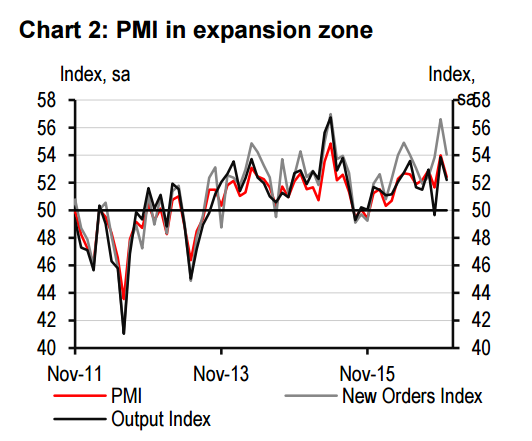Backed by a strong end of year with 2016’s fourth quarter GDP growth of 6.8 per cent and a growth rate of 6.2 per cent for the whole year, the primary driver of Vietnam’s robust economic expansion is manufacturing, HSBC wrote in its latest report.

Despite a disappointing start in 2016, economic growth gathered pace in the second half accelerating to 6.8 per cent year-on-year in the fourth quarter from below 6 per cent earlier in the year.
Agricultural production stabilized during the quarter, after a severe drought, while output in mining and quarrying declined. This was, however, offset by robust growth in manufacturing.
Construction activity also picked up, reflecting ongoing infrastructure investment and strength in the housing market.
Vietnam continues to gain global market share in key products, ranging from apparel to electronics, partly reflecting the economy’s integration into the regional supply chains of multinational companies. The country’s highly competitive labor force is a key attraction, leading to another record high of FDI disbursement in 2016.
As of December 26, 2016, foreign direct investment (FDI) worth $15.8 billion was disbursed. This is about 9 per cent more than what was disbursed in 2015. The largest contributions came from Korea, Japan, and Singapore – in that order. All in all, about 19 sectors received FDI, but the largest share was absorbed by the manufacturing sector.
In December, industrial production accelerated 7.8 per cent year-on-year, from 7.4 per cent in the previous month. Double-digit growth in manufacturing production, which accounts for 75 per cent of total industrial production, helped offset yet another steep fall in mining and quarrying output.
The readings of the manufacturing PMI are also in agreement. At 52.4, the December PMI was solid and reflected sustained improvements in operating conditions of the sector. Gains in new orders, including those in new export orders, kept production ticking along.
Confidence in the sector is further bolstered by firms’ decisions to hire more staff and accumulate inventory – of both preproduction and finished goods.
All this signals expectations of higher demand, and thereby stronger economic growth in the quarters to come.
But while macroeconomic indicators are upbeat, fast paced economic expansion will not be sustainable without continued investment in infrastructure.
In Vietnam, there’s certainly a need for continued public investment in infrastructure to sustain the heady pace of economic expansion.
Domestic demand too, has been substantially underpinned by rapid credit growth and government spending which, if unchecked, could pose challenges in the medium term. Despite increased focus on efficiencies in government spending and tax collection, public debt has come under pressure.
Much of this debt is in the form of long term development assistance loans, which are likely to be rolled over on the back of the economy’s transition to a “middle income country” from a “low income country.”
Government accounts, however, appear a little stretched at the moment, highlighting the need for public finance reform.
This includes the sale of government stakes in State-owned enterprises (SOEs), a process that helps raise revenue, reduce potential future cost burdens like subsidies, and raise the efficiency of SOEs.
In a recent decision, the government announced the total rate of State ownership in “firms” that are set to be equitized (or privatized). Previously, the rates were fixed by “sector” leading to low divestment.
Faster divestment will open for the government some fiscal space to stimulate economic activity.
Although a small move, the decision highlights the government’s resolve to deepen structural reforms that should help improve the economy’s long-term growth prospects.
Reforms around public finance should not only include more effective management of public funds and better management of debt, but also a speedy equitization of SOEs. The current average divestment rate at SOEs is 8 per cent. In other words, the State still holds 92 per cent of charter capital post-equitization.
But the privatization reform was revitalized when a fresh decision was issued on 28 December 2016, where the government announced the total rate of state ownership in “firms” that are set to be equitized.
Previously, the government only regulated the extent of state ownership rates by sector, not specific SOEs, leading to low divestment.
Additionally, the decision lists 103 SOEs in which the state will hold a 100 per cent stake and a further 137 that will be equitized from 2016-2020. Among those to be equitized, the state will hold over 65 per cent of charter capital in four, 50-65 per cent in 27, and less than 50 per cent in 106.
SOEs operating in sectors such as national defense and security, nuclear power, and money printing will not be equitized. This decision supersedes the earlier one and comes into effect from 15 February, 2017 of which this will likely accelerate the divestment process, according to HSBC.
VN Economic Times